Size and Temperature Effects on Band Gap Analysis of a Defective Phononic Crystal Beam
Abstract
1. Introduction
2. Model and Formulation
3. Solution Methodology for Band Gap
3.1. TMM for Perfect Heated PC Microbeam
3.2. TMM for Defect Heated PC Microbeam
4. Band Gap Analysis
4.1. The Influence of Size Effect
4.2. The Influence of Temperature Effect
5. Conclusions
- Size effects significantly impact the band structure of the PC microbeam, leading to increased stiffness and higher band gap frequencies. However, the size effect is negligible on the macrostructure.
- The introduction of defect cells widens the band gap of the defective PC microbeam, revealing a smooth dispersion curve within the band gap known as the defect band.
- Temperature rises will cause thermal axial forces to appear at both ends of unit cells, leading to a decrease in band gaps and defect band frequencies for both current and classical models.
- Different defect modes result in a distinct mode shape of the defective PC microbeam at the frequency of the defect band. Elongation of the defect segment with lower stiffness produces an antisymmetric mode shape while shortening the defect segment corresponds to a symmetric mode shape. The mode shape of the heated defective PC microbeam remains largely unaffected by temperature.
- The vibration energy will be concentrated near the defective unit cells, which is conducive to energy collection or absorption at specific locations.
Author Contributions
Funding
Data Availability Statement
Conflicts of Interest
References
- Kushwaha, M.S.; Halevi, P.; Martínez, G.; Dobrzynski, L.; Djafari-Rouhani, B. Theory of Acoustic Band Structure of Periodic Elastic Composites. Phys. Rev. B 1994, 49, 2313. [Google Scholar] [CrossRef]
- Liu, J.; Guo, H.; Wang, T. A Review of Acoustic Metamaterials and Phononic Crystals. Crystals 2020, 10, 305. [Google Scholar] [CrossRef]
- Zhang, G.Y.; Gao, X.L. Band gaps for wave propagation in 2-D periodic three-phase composites with coated star-shaped inclusions and an orthotropic matrix. Compos. Part B Eng. 2020, 182, 107319. [Google Scholar] [CrossRef]
- Zhang, G.Y.; He, Z.Z.; Qin, J.W.; Hong, J. Magnetically Tunable Bandgaps in Phononic Crystal Nanobeams Incorporating Microstructure and Flexoelectric Effects. Appl. Math. Model. 2022, 111, 554–566. [Google Scholar] [CrossRef]
- Plisson, J.; Pelat, A.; Gautier, F.; Garcia, V.R.; Bourdon, T. Experimental Evidence of Absolute Bandgaps in Phononic Crystal Pipes. Appl. Phys. Lett. 2020, 116, 201902. [Google Scholar] [CrossRef]
- Faiz, M.S.; Addouche, M.; Zain, A.R.M.; Siow, K.S.; Chaalane, A.; Khelif, A. Experimental Demonstration of a Multichannel Elastic Wave Filter in a Phononic Crystal Slab. Appl. Sci. 2020, 10, 4594. [Google Scholar] [CrossRef]
- Ozer, Z.; Demir, M.; Mamedov, A.M.; Ozbay, E. Band Structure of Phononic Crystal Consist of Hollow Aluminum Cylinders in Different Media; Finite Element Analysis. IOP Conf. Ser. Mater. Sci. Eng. 2019, 613, 012018. [Google Scholar] [CrossRef]
- Sun, Y.J.; Yu, Y.J.; Zuo, Y.Y.; Qiu, L.L.; Dong, M.M.; Ye, J.T.; Yang, J. Band Gap and Experimental Study in Phononic Crystals with Super-Cell Structure. Results Phys. 2019, 13, 102200. [Google Scholar] [CrossRef]
- Wu, F.; Hou, Z.; Liu, Z.; Liu, Y. Point Defect States in Two-Dimensional Phononic Crystals. Phys. Lett. A 2001, 292, 198–202. [Google Scholar] [CrossRef]
- Jiang, P.; Wang, X.P.; Chen, T.N.; Zhu, J. Band Gap and Defect State Engineering in a Multi-Stub Phononic Crystal Plate. J. Appl. Phys. 2015, 117, 154301. [Google Scholar] [CrossRef]
- Sigalas, M.M. Elastic Wave Band Gaps and Defect States in Two-Dimensional Composites. J. Acoust. Soc. Am. 1997, 101, 1256–1261. [Google Scholar] [CrossRef]
- Zhang, G.Y.; Gao, X.Y.; Wang, S.P.; Hong, J. Bandgap and Its Defect Band Analysis of Flexoelectric Effect in Phononic Crystal Plates. Eur. J. Mech. A/Solids 2024, 104, 105192. [Google Scholar] [CrossRef]
- Li, Y.; Chen, T.; Wang, X.; Ma, T.; Jiang, P. Acoustic Confinement and Waveguiding in Two-Dimensional Phononic Crystals with Material Defect States. J. Appl. Phys. 2014, 116, 024904. [Google Scholar] [CrossRef]
- Yao, Z.J.; Yu, G.L.; Wang, Y.S.; Shi, Z.F. Propagation of Bending Waves in Phononic Crystal Thin Plates with a Point Defect. Int. J. Solids Struct. 2009, 46, 2571–2576. [Google Scholar] [CrossRef]
- Jo, S.H.; Yoon, H.; Shin, Y.C.; Youn, B.D. Revealing Defect-Mode-Enabled Energy Localization Mechanisms of a One-Dimensional Phononic Crystal. Int. J. Mech. Sci. 2022, 215, 106950. [Google Scholar] [CrossRef]
- Kherraz, N.; Chikh-Bled, F.H.; Sainidou, R.; Morvan, B.; Rembert, P. Tunable Phononic Structures Using Lamb Waves in a Piezoceramic Plate. Phys. Rev. B 2019, 99, 094302. [Google Scholar] [CrossRef]
- Chen, S.; Wen, J.; Wang, G.; Yu, D.; Wen, X. Improved Modeling of Rods with Periodic Arrays of Shunted Piezoelectric Patches. J. Intell. Mater. Syst. Struct. 2012, 23, 1613–1621. [Google Scholar] [CrossRef]
- Wang, Y.; Zhang, C.; Chen, W.; Li, Z.; Golub, M.V.; Fomenko, S.I. Precise and Target-Oriented Control of the Low-Frequency Lamb Wave Bandgaps. J. Sound Vib. 2021, 511, 116367. [Google Scholar] [CrossRef]
- Zhang, S.; Gao, Y. Gap Evolution of Lamb Wave Propagation in Magneto-Elastic Phononic Plates with Pillars and Holes by Modulating Magnetic Field and Stress Loadings. J. Appl. Phys. 2018, 124, 244102. [Google Scholar] [CrossRef]
- Bian, Z.; Peng, W.; Song, J. Thermal Tuning of Band Structures in a One-Dimensional Phononic Crystal. J. Appl. Mech. 2014, 81, 041008. [Google Scholar] [CrossRef]
- Gu, C.; Jin, F. Research on the Tunability of Point Defect Modes in a Two-Dimensional Magneto-Elastic Phononic Crystal. J. Phys. D Appl. Phys. 2016, 49, 175103. [Google Scholar] [CrossRef]
- Deng, T.; Zhang, S.; Gao, Y. Tunability of Band Gaps and Energy Harvesting Based on the Point Defect in a Magneto-Elastic Acoustic Metamaterial Plate. Appl. Phys. Express 2020, 13, 015503. [Google Scholar] [CrossRef]
- Shakeri, A.; Darbari, S.; Moravvej-Farshi, M.K. Designing a Tunable Acoustic Resonator Based on Defect Modes, Stimulated by Selectively Biased PZT Rods in a 2D Phononic Crystal. Ultrasonics 2019, 92, 8–12. [Google Scholar] [CrossRef]
- Qu, Y.L.; Zhang, G.Y.; Gao, X.L.; Jin, F. A New Model for Thermally Induced Redistributions of Free Carriers in Centrosymmetric Flexoelectric Semiconductor Beams. Mech. Mater. 2022, 171, 104328. [Google Scholar] [CrossRef]
- Zhang, G.Y.; Guo, Z.W.; Qu, Y.L.; Gao, X.L.; Jin, F. A New Model for Thermal Buckling of an Anisotropic Elastic Composite Beam Incorporating Piezoelectric, Flexoelectric and Semiconducting Effects. Acta Mech. 2022, 233, 1719–1738. [Google Scholar] [CrossRef]
- Hu, A.; Zhang, X.; Wu, F.; Yao, Y.; Cheng, C.; Huang, P. Temperature Effects on the Defect States in Two-Dimensional Phononic Crystals. Phys. Lett. A 2014, 378, 2239–2244. [Google Scholar] [CrossRef]
- Geng, Q.; Cai, T.; Li, Y. Flexural Wave Manipulation and Energy Harvesting Characteristics of a Defect Phononic Crystal Beam with Thermal Effects. J. Appl. Phys. 2019, 125, 035103. [Google Scholar] [CrossRef]
- Geng, Q.; Wang, T.; Wu, L.; Li, Y. Defect Coupling Behavior and Flexural Wave Energy Harvesting of Phononic Crystal Beams with Double Defects in Thermal Environments. J. Phys. D Appl. Phys. 2021, 54, 225501. [Google Scholar] [CrossRef]
- Lam, D.C.C.; Yang, F.; Chong, A.C.M.; Wang, J.; Tong, P. Experiments and Theory in Strain Gradient Elasticity. J. Mech. Phys. Solids 2003, 51, 1477–1508. [Google Scholar] [CrossRef]
- Liebold, C.; Müller, W.H. Comparison of Gradient Elasticity Models for the Bending of Micromaterials. Comput. Mater. Sci. 2016, 116, 52–61. [Google Scholar] [CrossRef]
- Patel, B.N.; Srinivasan, S.M. Novel Nickle Foil Micro-Bend Tests and the Need for a Relook at Length Scale Parameter’s Numerical Value. Mech. Adv. Mater. Struct. 2022, 29, 3924–3933. [Google Scholar] [CrossRef]
- Choi, J.H.; Kim, H.; Kim, J.Y.; Lim, K.H.; Lee, B.C.; Sim, G.D. Micro-Cantilever Bending Tests for Understanding Size Effect in Gradient Elasticity. Mater. Des. 2022, 214, 110398. [Google Scholar] [CrossRef]
- Li, Z.; He, Y.; Lei, J.; Han, S.; Guo, S.; Liu, D. Experimental Investigation on Size-Dependent Higher-Mode Vibration of Cantilever Microbeams. Microsyst. Technol. 2019, 25, 3005–3015. [Google Scholar] [CrossRef]
- Lei, J.; He, Y.; Guo, S.; Li, Z.; Liu, D. Size-Dependent Vibration of Nickel Cantilever Microbeams: Experiment and Gradient Elasticity. AIP Adv. 2016, 6, 105202. [Google Scholar] [CrossRef]
- Zhang, G.Y.; Qu, Y.L.; Guo, Z.W.; Jin, F. Magnetically Induced Electric Potential in First-Order Composite Beams Incorporating Couple Stress and Its Flexoelectric Effects. Acta Mech. Sin. 2021, 37, 1509–1519. [Google Scholar] [CrossRef]
- Zhang, G.Y.; Gao, X.L. A Non-Classical Kirchhoff Rod Model Based on the Modified Couple Stress Theory. Acta Mech. 2019, 230, 243–264. [Google Scholar] [CrossRef]
- Qu, Y.L.; Zhang, G.Y.; Fan, Y.M.; Jin, F. A Non-Classical Theory of Elastic Dielectrics Incorporating Couple Stress and Quadrupole Effects: Part I – Reconsideration of Curvature-Based Flexoelectricity Theory. Math. Mech. Solids 2021, 26, 1647–1659. [Google Scholar] [CrossRef]
- Chen, J.B.; Qu, Y.L.; Guo, Z.W.; Li, D.B.; Zhang, G.Y. A One-Dimensional Model for Mechanical Coupling Metamaterials Using Couple Stress Theory. Math. Mech. Solids 2023, 28, 2732–2755. [Google Scholar] [CrossRef]
- Zhang, G.Y.; Gao, X.L.; Zheng, C.Y.; Mi, C.W. A Non-Classical Bernoulli-Euler Beam Model Based on a Simplified Micromorphic Elasticity Theory. Mech. Mater. 2021, 161, 103967. [Google Scholar] [CrossRef]
- Zhang, G.Y.; Gao, X.L. A Non-Classical Model for First-Ordershear Deformation Circular Cylindrical Thin Shells Incorporating Microstructure and Surface Energy Effects. Math. Mech. Solids 2021, 26, 1294–1319. [Google Scholar] [CrossRef]
- Zhang, G.Y.; Gao, X.L.; Littlefield, A.G. A Non-Classical Model for Circular Cylindrical Thin Shells Incorporating Microstructure and Surface Energy Effects. Acta Mech. 2021, 232, 2225–2248. [Google Scholar] [CrossRef]
- Qu, Y.L.; Li, P.; Zhang, G.Y.; Jin, F.; Gao, X.L. A Microstructure-Dependent Anisotropic Magneto-Electro-Elastic Mindlin Plate Model Based on an Extended Modified Couple Stress Theory. Acta Mech. 2020, 231, 4323–4350. [Google Scholar] [CrossRef]
- Qu, Y.; Li, P.; Jin, F. A General Dynamic Model Based on Mindlin’s High-Frequency Theory and the Microstructure Effect. Acta Mech. 2020, 231, 3847–3869. [Google Scholar] [CrossRef]
- Qu, Y.; Li, P.; Jin, F. A General Dynamic Theoretical Model of Elastic Micro-Structures with Consideration of Couple Stress Effects and Its Application in Mechanical Analysis of Size-Dependent Properties. Acta Mech. 2020, 231, 471–488. [Google Scholar] [CrossRef]
- Kolter, W.T. Couple Stresses in the Theory of Elasticity. Proc. K. Ned. Akad. Wet. B 1964, 67, 17–44. [Google Scholar]
- Mindlin, R.D.; Eshel, N.N. On First Strain-Gradient Theories in Linear Elasticity. Int. J. Solids Struct. 1968, 4, 109–124. [Google Scholar] [CrossRef]
- Eringen, A.C. Nonlocal Polar Elastic Continua. Int. J. Eng. Sci. 1972, 10, 1–16. [Google Scholar] [CrossRef]
- Gurtin, M.E.; Ian Murdoch, A. A Continuum Theory of Elastic Material Surfaces. Arch. Ration. Mech. Anal. 1975, 57, 291–323. [Google Scholar] [CrossRef]
- Zhang, G.Y.; Gao, X.L. A New Bernoulli–Euler Beam Model Based on a Reformulated Strain Gradient Elasticity Theory. Math. Mech. Solids 2020, 25, 630–643. [Google Scholar] [CrossRef]
- Hong, J.; Wang, S.P.; Zhang, G.Y.; Mi, C.W. Bending, Buckling and Vibration Analysis of Complete Microstructure-Dependent Functionally Graded Material Microbeams. Int. J. Appl. Mech. 2021, 13, 2150057. [Google Scholar] [CrossRef]
- Wang, S.P.; Hong, J.; Wei, D.; Zhang, G.Y. Bending and Wave Propagation Analysis of Axially Functionally Graded Beams Based on a Reformulated Strain Gradient Elasticity Theory. Appl. Math. Mech. Engl. Ed. 2023, 44, 1803–1820. [Google Scholar] [CrossRef]
- Zhang, G.Y.; Qu, Y.L.; Gao, X.L.; Jin, F. A Transversely Isotropic Magneto-Electro-Elastic Timoshenko Beam Model Incorporating Microstructure and Foundation Effects. Mech. Mater. 2020, 149, 103412. [Google Scholar] [CrossRef]
- Hong, J.; Wang, S.P.; Zhang, G.Y.; Mi, C.W. On the Bending and Vibration Analysis of Functionally Graded Magneto-Electro-Elastic Timoshenko Microbeams. Crystals 2021, 11, 1206. [Google Scholar] [CrossRef]
- Hong, J.; Wang, S.P.; Qiu, X.Y.; Zhang, G.Y. Bending and Wave Propagation Analysis of Magneto-Electro-Elastic Functionally Graded Porous Microbeams. Crystals 2022, 12, 732. [Google Scholar] [CrossRef]
- Park, S.K.; Gao, X.L. Bernoulli–Euler Beam Model Based on a Modified Couple Stress Theory. J. Micromech. Microeng. 2006, 16, 2355. [Google Scholar] [CrossRef]
- Yang, F.; Chong, A.C.M.; Lam, D.C.C.; Tong, P. Couple Stress Based Strain Gradient Theory for Elasticity. Int. J. Solids Struct. 2002, 39, 2731–2743. [Google Scholar] [CrossRef]
- Park, S.K.; Gao, X.L. Variational Formulation of a Modified Couple Stress Theory and Its Application to a Simple Shear Problem. Z. Angew. Math. Phys. 2008, 59, 904–917. [Google Scholar] [CrossRef]
- Ma, H.M.; Gao, X.L.; Reddy, J.N. A Microstructure-Dependent Timoshenko Beam Model Based on a Modified Couple Stress Theory. J. Mech. Phys. Solids 2008, 56, 3379–3391. [Google Scholar] [CrossRef]
- Chuang, K.C.; Zhang, Z.Q.; Wang, H.X. Experimental Study on Slow Flexural Waves around the Defect Modes in a Phononic Crystal Beam Using Fiber Bragg Gratings. Phys. Lett. A 2016, 380, 3963–3969. [Google Scholar] [CrossRef]
- Zhang, G.Y.; Gao, X.L.; Ding, S.R. Band Gaps for Wave Propagation in 2-D Periodic Composite Structures Incorporating Microstructure Effects. Acta Mech. 2018, 229, 4199–4214. [Google Scholar] [CrossRef]
- Tsagareishvili, G.V.; Nakashidze, T.G.; Jobava, J.S.; Lomidze, G.P.; Khulelidze, D.E.; Tsagareishvili, D.S.; Tsagareishvili, O.A. Thermal Expansion of Boron and Boron Carbide. J. Less Common Met. 1986, 117, 159–161. [Google Scholar] [CrossRef]
- Hong, J.; He, Z.; Zhang, G.; Mi, C. Size and Temperature Effects on Band Gaps in Periodic Fluid-Filled Micropipes. Appl. Math. Mech. Engl. Ed. 2021, 42, 1219–1232. [Google Scholar] [CrossRef]
- Zergoune, Z.; Kacem, N.; Bouhaddi, N. On the energy localization in weakly coupled oscillators for electromagnetic vibration energy harvesting. Smart Mater. Struct. 2019, 28, 07LT02. [Google Scholar] [CrossRef]



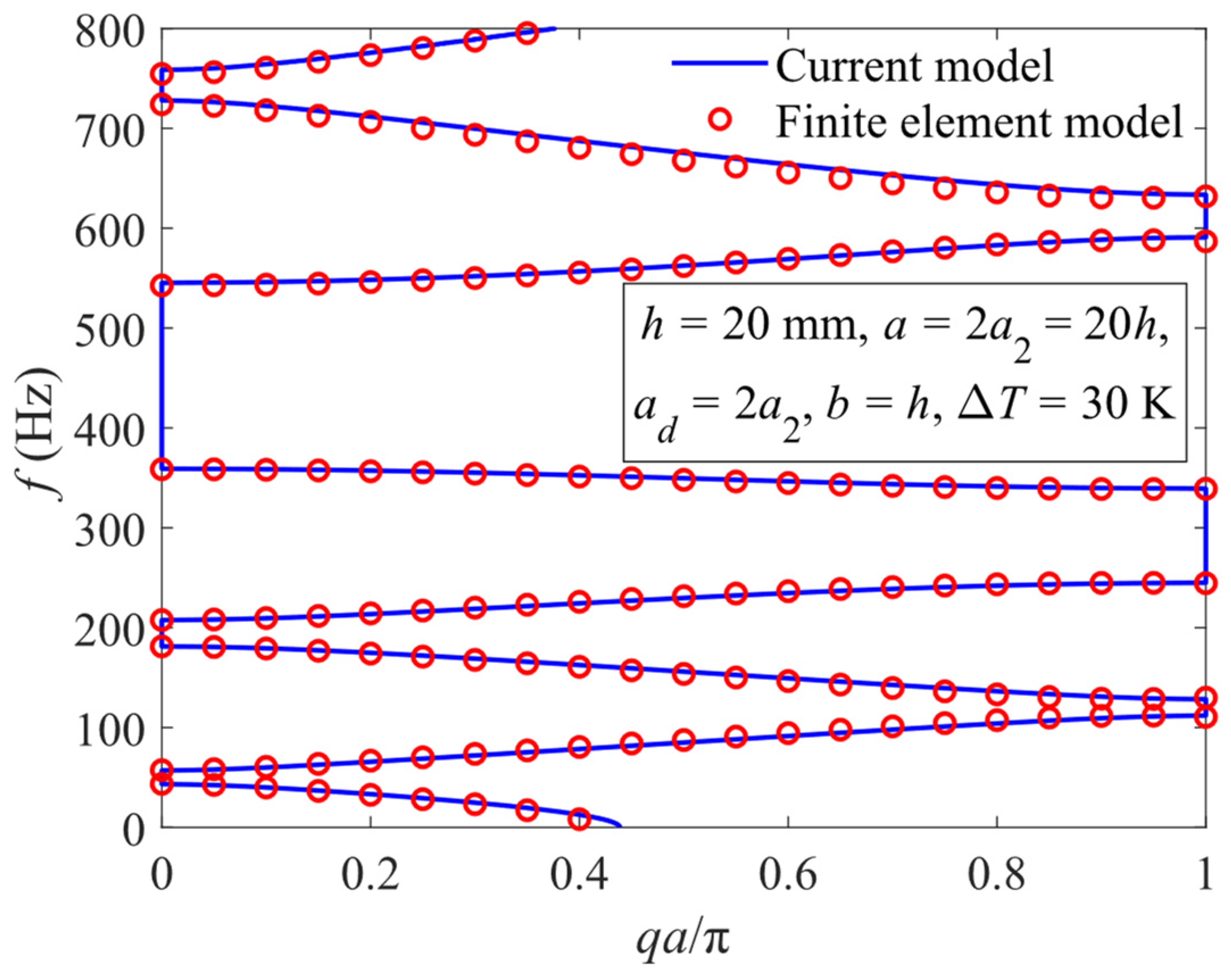
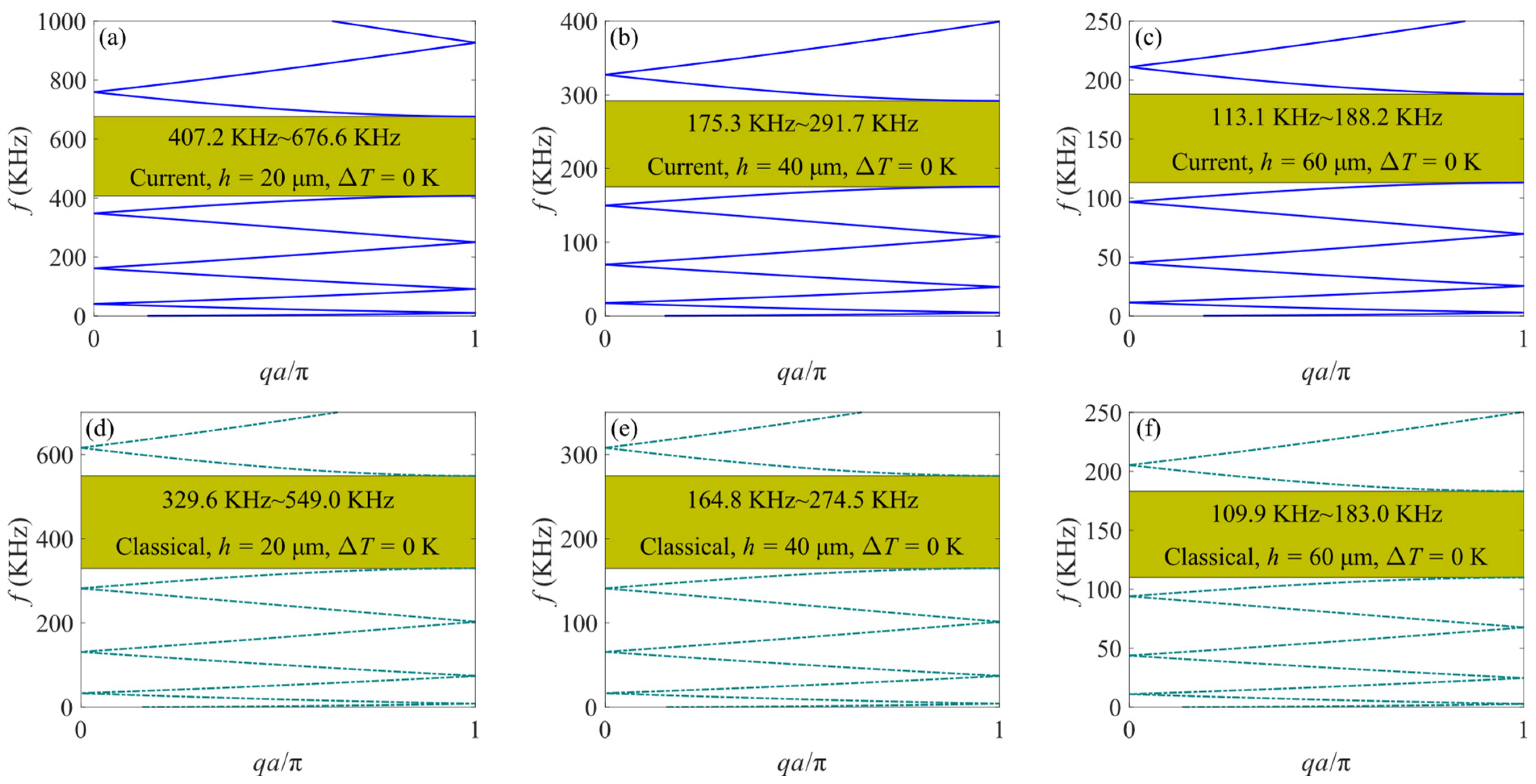
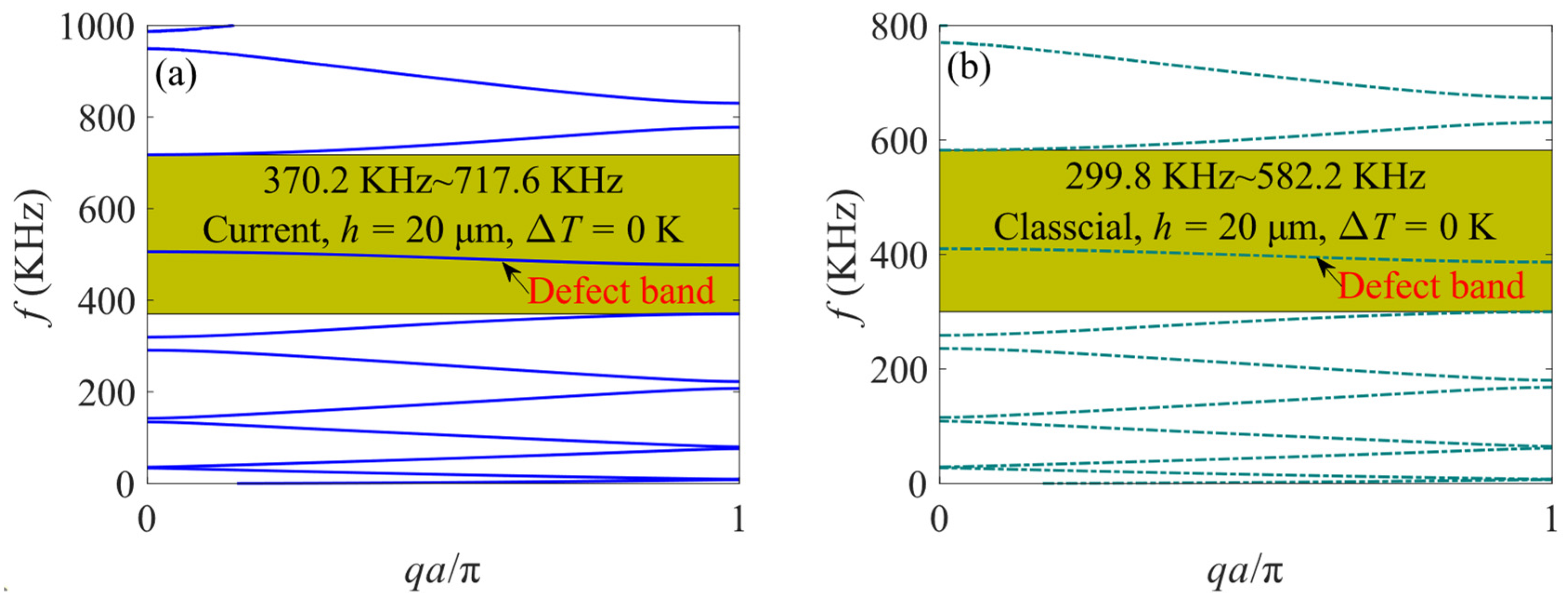
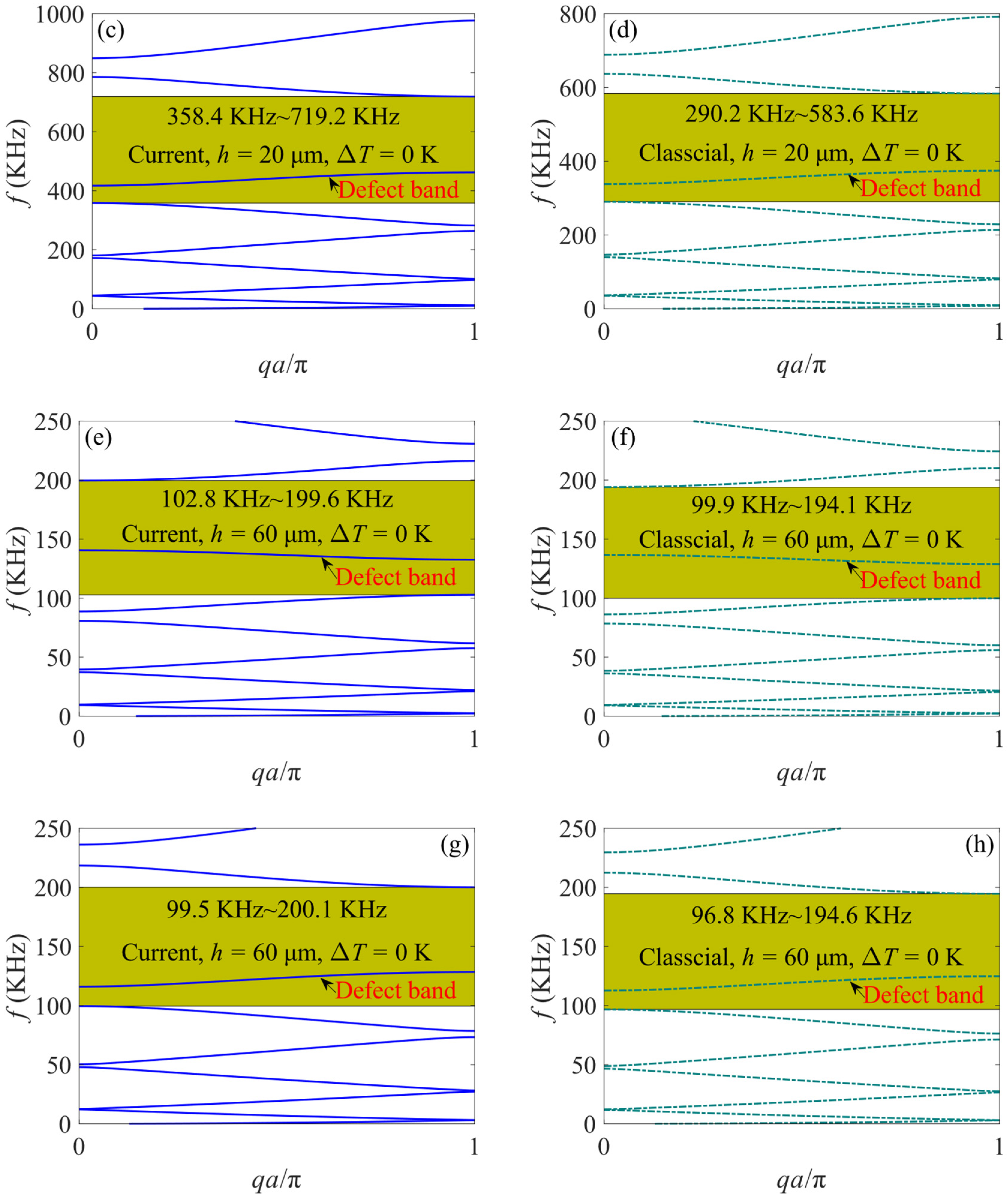

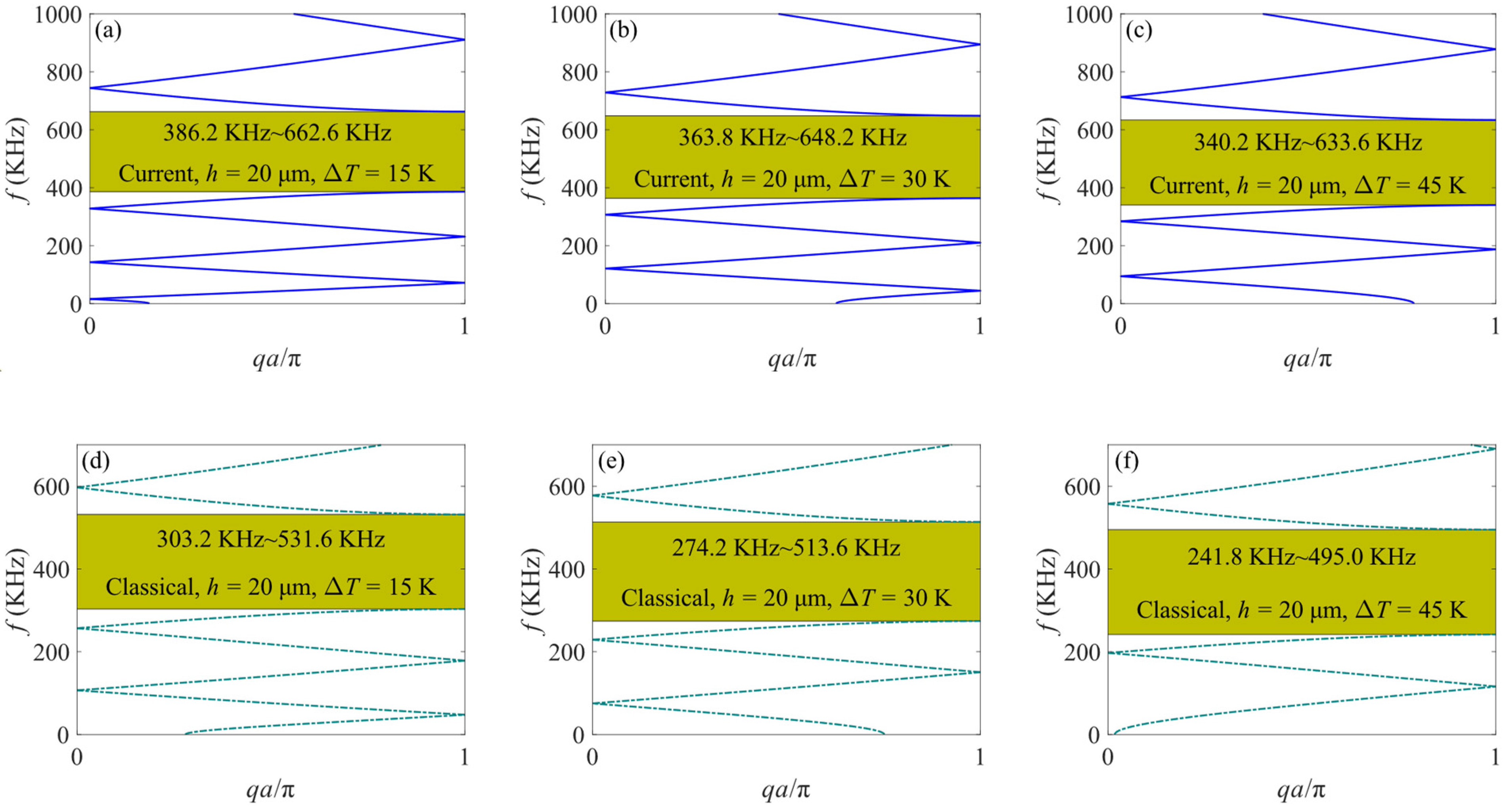
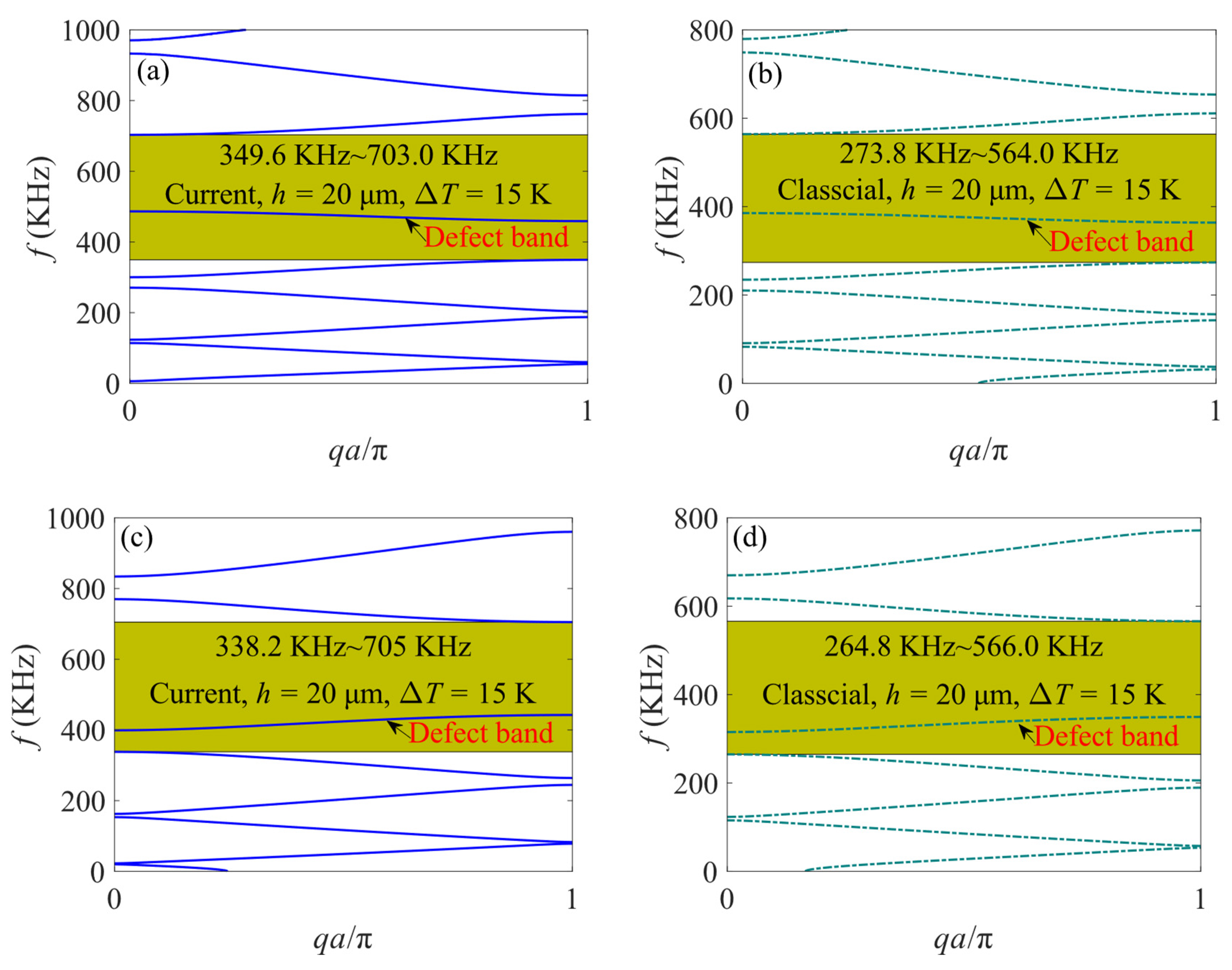
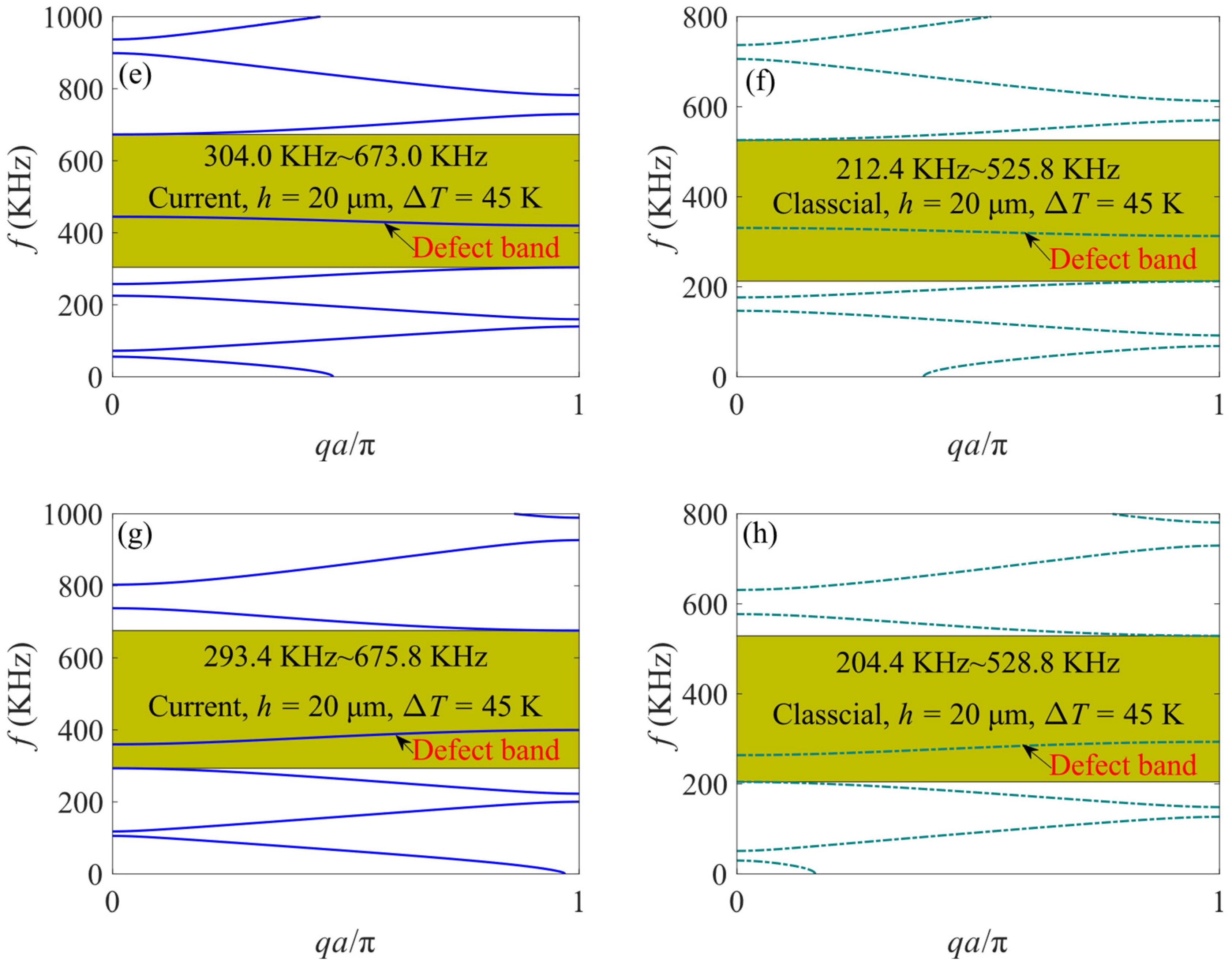
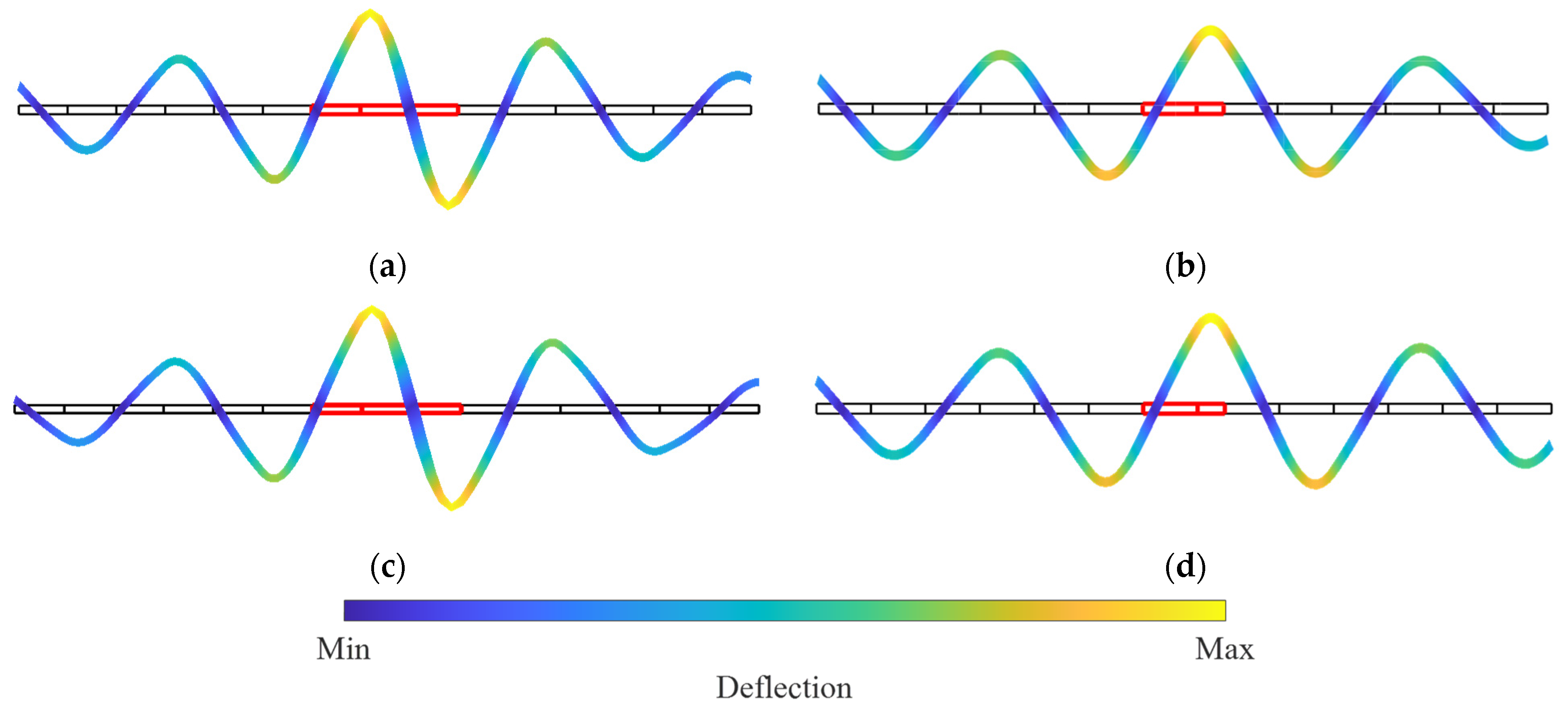
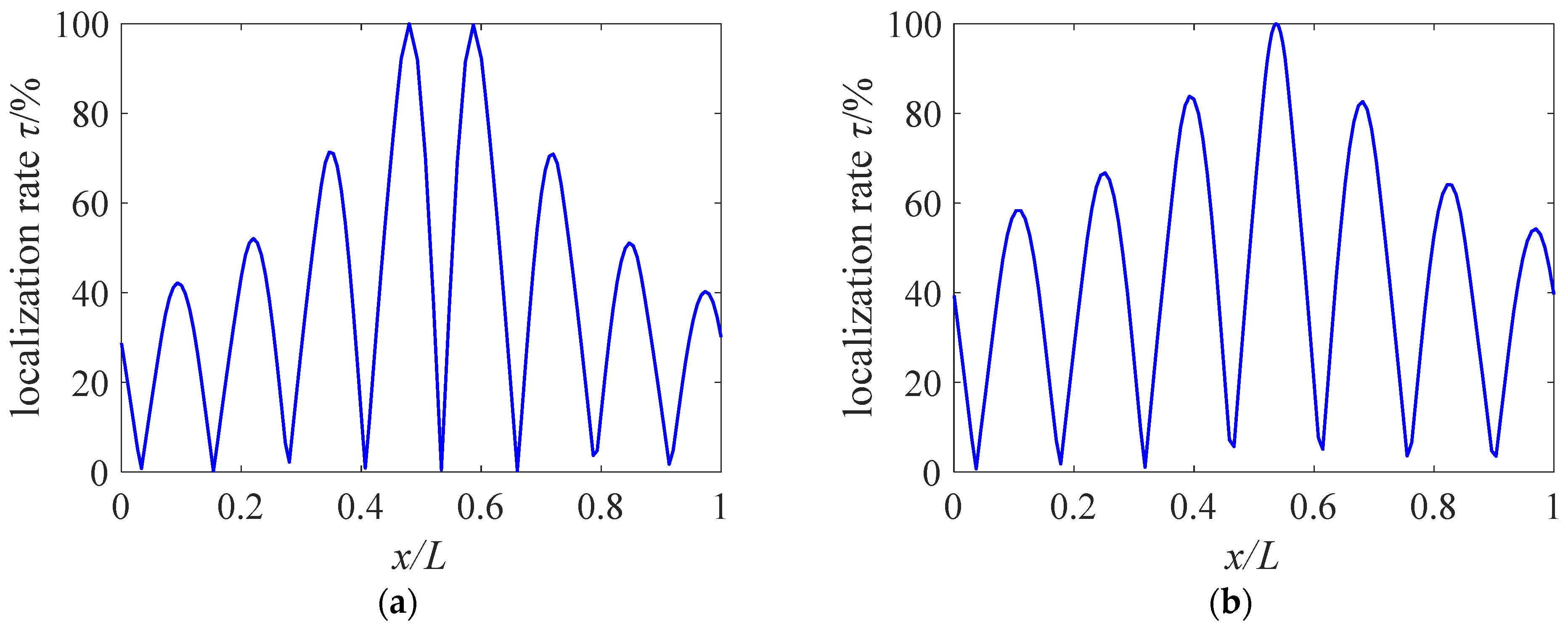
Disclaimer/Publisher’s Note: The statements, opinions and data contained in all publications are solely those of the individual author(s) and contributor(s) and not of MDPI and/or the editor(s). MDPI and/or the editor(s) disclaim responsibility for any injury to people or property resulting from any ideas, methods, instructions or products referred to in the content. |
© 2024 by the authors. Licensee MDPI, Basel, Switzerland. This article is an open access article distributed under the terms and conditions of the Creative Commons Attribution (CC BY) license (https://creativecommons.org/licenses/by/4.0/).
Share and Cite
Yao, B.; Wang, S.; Hong, J.; Gu, S. Size and Temperature Effects on Band Gap Analysis of a Defective Phononic Crystal Beam. Crystals 2024, 14, 163. https://doi.org/10.3390/cryst14020163
Yao B, Wang S, Hong J, Gu S. Size and Temperature Effects on Band Gap Analysis of a Defective Phononic Crystal Beam. Crystals. 2024; 14(2):163. https://doi.org/10.3390/cryst14020163
Chicago/Turabian StyleYao, Bin, Shaopeng Wang, Jun Hong, and Shuitao Gu. 2024. "Size and Temperature Effects on Band Gap Analysis of a Defective Phononic Crystal Beam" Crystals 14, no. 2: 163. https://doi.org/10.3390/cryst14020163
APA StyleYao, B., Wang, S., Hong, J., & Gu, S. (2024). Size and Temperature Effects on Band Gap Analysis of a Defective Phononic Crystal Beam. Crystals, 14(2), 163. https://doi.org/10.3390/cryst14020163







